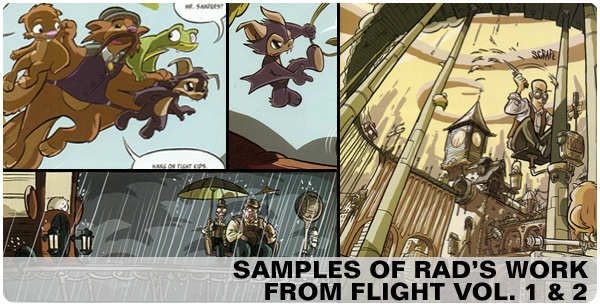

| Geek Fact |
| Did you know that Aardman Animation's movie, Wallace & Gromit: The Curse of the Were-Rabbit was filmed on 33 miniature sets? It was filmed on the floor of Aardman's feature studio in the "Aztec West" industrial park in Bristol where Aardman Animations made Chicken Run. Also, they used their own special blend of Plasticine (modeling clay), nicknamed "Aard-mix" which is slightly more durable than ordinary Plasticine. Finally, The Moving Picture Co. completed more than 750 visual effects shots for the movie. |

|
|
Book Showcase: Flight - Volume 1 & 2
|
|
Rad Sechrist was mentored by the late Sam Singer, an old Disney animator who went on to produce television cartoons. After high school, he went to UC Santa Barbara where he graduated with a Mechanical Engineering degree.
While he was there, he worked at the college newspaper, the Daily Nexus, producing one to three illustrations a day. After graduating in 2004, he went on to be a freelance cartoonist. He has since been published in Flight Volumes 1, 2, and 3 (upcoming). He is currently working on Barnes and Nobles' upcoming classic comic series, specifically Tom Sawyer. AnimationMentor.com: How did you get involved with Flight? We were just a bunch of friends that all got together and decided to compile some short stories for fun. It slowly grew into its own thing, and Image Comics published the first two volumes. We never imagined for it to be the project that it is now, and we always try to keep the focus on having our readers enjoy the stories. Be on the lookout for the third volume being published by Random House coming in 2006! AnimationMentor.com: Can you tell us about Flight? In the comics industry, the writing and the illustration tends to be done by separate people. The idea behind Flight was to have the artists write their own stories. This is also a good place for people to test the waters for story ideas they have, before trying to launch into their own series. AnimationMentor.com: How did you get into Animation? I had a lot of animation books growing up, and I loved the focus on form. I would practice for hours growing up, trying to replicate the style of the Disney animators. You can't cheat, and it forces you to really understand what you're drawing. You can get more info about Flight here. You can see and learn more about Rad Sechrist here.  |
|
December US Movie Releases
Your inside guide to US movie releases and the visual effect companies who made movie magic.
|
|
Aeon Flux
U.S. Release Date: December 02, 2005
Visual Effects Studio: BUF Compagnie Synopsis: Based on Peter Chung's animated TV series, the story is set 400 years in the future where humankind must live in bubbled city due to a killer virus. A female assassin must kill the government leader. |
|
The Chronicles of Narnia: The Lion, the Witch and the Wardrobe
U.S. Release Date: December 09, 2005
Visual Effects Studio: Rhythm & Hues Synopsis: Based on C.S. Lewis' famed children's novel, the story follows four children who discover a gateway to the fantasy land of Narnia in the back of a wardrobe closet. |
|
King Kong
U.S. Release Date: December 14, 2005
Visual Effects Studio: Weta Digital Synopsis: LORD OF THE RINGS director Peter Jackson is bringing his vision of the horror classic KING KONG to the big screen. |
|
Hoodwinked!
U.S. Release Date: December 23, 2005
Visual Effects Studio: Weinstein Company Synopsis: ittle Red Riding Hood: A classic story, but there's more to every tale than meets the eye. Before you judge a book by its cover, you've got to flip through the pages. |

